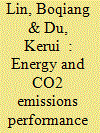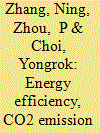| Srl | Item |
| 1 |
ID:
137744


|
|
|
|
|
| Summary/Abstract |
This paper employs a newly developed non-radial directional distance function to evaluate China's regional energy and CO2 emission performance for the period 1997–2009. Moreover, we analyze the impact of China's market-oriented reform on China's regional energy and carbon efficiency. The main findings are as follows. First, most of China's regions did not perform efficiently in energy use and CO2 emissions. Provinces in the east area generally performed better than those in the central and west areas. By contrast, provinces in the west area generally evidenced the lowest efficiency. Second, Market-oriented reforms, especially the promotion of factor market, were found to have positive effect on the efficiency of energy use and CO2 emissions. Third, the share of coal in the total energy consumption and the expansion of the industrial sector were found to be negatively correlated with China's regional energy and CO2 emissions performance. Based on the empirical findings, we provide policy suggestions for enhancing energy and carbon efficiency in China.
|
|
|
|
|
|
|
|
|
|
|
|
|
|
|
|
| 2 |
ID:
121323


|
|
|
|
|
| Publication |
2013.
|
| Summary/Abstract |
This paper proposes a meta-frontier non-radial directional distance function to model energy and CO2 emission performance in electricity generation. This approach allows for the consideration of the group heterogeneity of electricity generation, non-radial slacks, and undesirable outputs simultaneously. We extend several standardized indices to measure total-factor energy efficiency, CO2 emission performance, and technology gaps in electricity generation. We estimate the potential reductions in energy use and CO2 emissions under different technology assumptions. We conduct an empirical analysis of fossil fuel electricity generation in Korea by using the proposed approach. The results indicate that coal-fired power plants show higher levels of total-factor energy efficiency and CO2 emission performance than oil-fired ones. Under the meta-frontier technology assumption, coal-fired power plants show a smaller technology gap than oil-fired ones. This suggests that the Korean government should promote technological innovation to reduce technology gaps for oil-fired plants, thereby improving energy and CO2 emission performance and meeting emission reduction targets in the electricity generation industry.
|
|
|
|
|
|
|
|
|
|
|
|
|
|
|
|